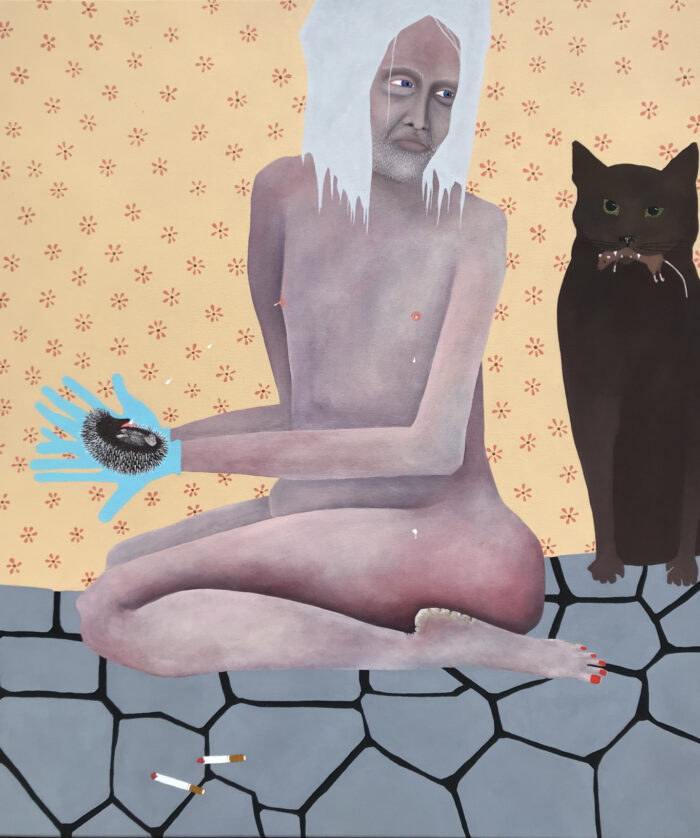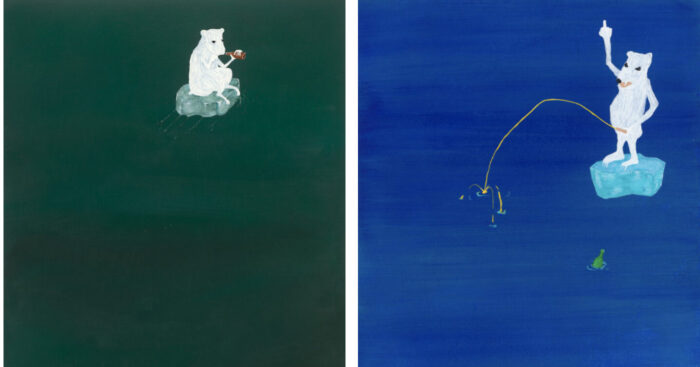
Thordis Adalsteinsdottir: Some of It May Have Started at the Rivera
Nunu Fine Art
For trained painters, choosing to paint flatly is a deliberate decision. Thordis Adalsteinsdottir creates textureless effects to draw viewers’ attention to details, both large and small, in her surrealistic works. Her solo exhibition, “Some of It May Have Started at the River,” at Nunu Fine Art showcases these intentional choices that encourage a focused examination. The flatness heightens the viewing process, enabling the audience to ponder the eerie nonchalance of the characters in her acrylic and flashe on canvas paintings. Each stroke carries intentionality, and nothing is frivolous.
Textureless does not imply patternless. Adalsteinsdottir’s work is rich in patterns, encompassing repetition of motifs and actual print patterns for walls and fabrics. Although she includes modern elements like cell phones, circuit boards, outlets, surveillance cameras, and smoke detectors, the majority of subjects and objects remain familiar, such as human figures, domestic animals, household items, and landscapes.Like most naturalistic surrealistic paintings, the relatable subjects are in unusual scales to juxtapose interesting combinations and produce whimsy. However, in a departure from traditional surrealism, Adalsteinsdottir incorporates the post-pop flat aesthetic to establish a category of her own.

This unique union results in an exploration of human behavior. Absent the usual emotive brushwork in surrealist works that divert attention from the content, Adalsteinsdottir focuses on the absurd. In Teacher (2023), an androgynous figure massages a hedgehog with pale blue gloves while a cat kills a mouse in its mouth nearby, presumably under human orders. This lighthearted yet raw scene highlights the peculiarity of what humans deem worthy of love and what’s considered repellent. The nude non-binary person depicted is often the target of such violence, deemed unworthy of safety and security. The blend of humor and post-pop social critique illustrates a subtly heartless and uncaring humanity.

Adalsteinsdottir exposes another human flaw through Some of It May Have Started by the River (2023) and her Polar Bear series (2022). In the latter, anthropomorphized bears, appearing angry and drunk, stand and sit on melting ice caps, gesturing obscenely at the off-frame humans for their behaviors that created the crisis of melting ice caps. In the former, a flooding river embraces a calm woman in a bicycle helmet with a surveillance camera observing a small bathtub holding a woman with three strawberries and a black cat massaging her toes and drinking wine, an oversized smoking hamster, and a cell phone and a mushroom protected by bottles against a fabric-draped landscape with sliced apples, a cup of coffee in a traditional Danish cup, and cotton ball clouds. This imagery of the human figure suggests a lobster in boiling water, unaware of imminent danger. Adalsteinsdottir’s use of whimsy to address serious topics like global warming serves as a gentle entry point for viewers to reflect on their vulnerability.

The fragility of humanity’s existence on this planet is apparent. Adalsteinsdottir, much like the surrealist painters of the 1930s, signals a new era of tumult. She seamlessly weaves rich patterns into her paintings, incorporating familiar subjects and objects in unusual scales, juxtaposing whimsy, and producing intriguing combinations. Departing from naturalistic surrealism, she incorporates the post-pop flat aesthetic, resulting in a unique exploration of human behavior and social critique. As humans navigate the challenges ahead, humanity must rediscover love and care for one another. It is a crucial survival tool for what lies ahead. The open-ended question remains, as ever, is humanity capable of change?

